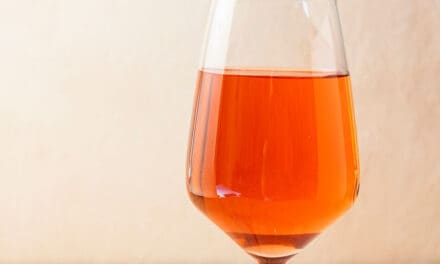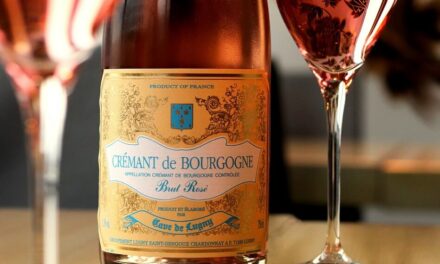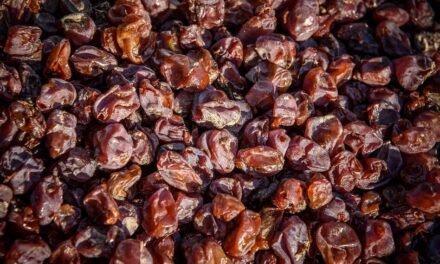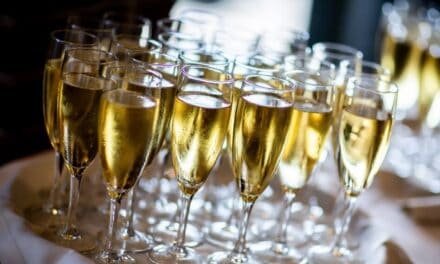For many wine lovers, Italy is the motherland of superb red wines. Among the numerous excellent wines from the South-European country, some stand out even more. One of the best and most famous Italian red wines is Barolo.
Barolo is a high-quality red wine from Italy. They are dry, full-bodied, high in tannins and alcohol, and typically feature fruity as well as earthy flavors. The Barolo DOCG appellation is located in the Piedmont region in the Northern part of the country.
Winemaking in this region has a fascinating history that resulted in strict wine laws and extraordinarily good wines. In this article, we will discuss the upcoming of these wines and how to enjoy them best.
WHAT GRAPE IS BAROLO MADE FROM?
By law, vintners may use only one red varietal to make Barolo wine: Nebbiolo. Those who use other grapes can’t write the name Barolo on their bottle labels.
Nebbiolo grapes are small and thin-skinned. They bud early in the year but are among the last to be harvested in late October. With high levels of acidity and tannins, they are perfect for making full-bodied, dry red wines.
WHERE DOES BAROLO WINE COME FROM?
Barolo wines come from the appellation with the same name. It is located in the Piedmont region in Northern Italy and consists of 11 communes:
- Barolo
- Castiglione Falletto
- Cherasco
- Diano d’Alba
- Grinzane Cavour
- La Morra
- Monforte d’Alba
- Novello
- Roddi
- Serralunga d’Alba
- Verduno
But even within these communes, vintners can only cultivate their vines in specific spots. Plantings on floor valleys and flat areas are prohibited; all vines must grow on south-facing hillsides with sufficient exposure to sunlight.

Barolo DOCG Wine Region
The Barolo appellation has the status Denominazione di Origine Controllata e Garantita (short: DOCG), which is the highest quality label for Italian wines. With its warm but temperate climate with long summers, the region provides the perfect conditions for healthy and tasty grapes. Nevertheless, the wines coming from single communes can differ perceivably in flavor because they are grown on different soils.
THE HISTORY OF BAROLO
Winegrowing in Piedmont started hundreds of years ago, and the Barolo appellation is no exception. The first mention of Nebbiolo grapes dates back to 1250.
However, for a long time, wines from the area were unknown outside of Piedmont. Even more interesting is that they had very different characteristics than modern Barolo. Because Nebbiolo grapes ripened very late in the year, the frost often set in shortly after the harvest. The cold stopped the fermentation, and thus, there was a lot of residual sugar left in the wine. Logically, the first wines were sweet.
In the middle of the 19th century, Camillo Benso, Count of Cavour and mayor of the town of Grinzane Cavour, started an initiative to improve wine quality. He invited Louis Oudart, a French wine expert, who taught his knowledge about wine growing and production processes to local vintners. He limited the yields, set rules for a clean working environment, and heated the fermentation areas to ensure that fermentation would not stop early. Soon, the first dry wine was produced based on these new processes. And it was so good that King Carlo Alberto of Savoy, then ruler of piedmont, praised it.
The Barolo Wars
Despite the rise in quality, Barolo remained a wine for the local market for a long time. In the second half of the 20th century, that changed, though. A few winemakers started to adapt production techniques from Burgundy vintners. With quick fermentation and maceration and the use of new, flavor-imparting oak barrels, they created more approachable wines. This approach contrasted the traditional winemaking processes that relied on slower fermentation periods and neutral barrels. The results were intense wines with aggressive tannins that were only enjoyable after an extensive aging time.
This time became known as the “Barolo Wars”. The conflict didn’t have a clear winner, though. Following it, especially wines made by following the new approaches, attracted some attention from wine experts and the media. But the public widely dismissed the traditionally produced wines.
Today, most vintners in the region follow a middle way between the two approaches. They put much more work into managing the vineyard and producing healthy grapes than they did before. Many wine lovers have shifted their opinion and acknowledge Barolo’s excellence now. But the extensive time it needs to reach its full potential still puts off some people.
HOW BAROLO IS MADE
The Nebbiolo grapes, which are used to make Barolo wines are late-ripening, and they need a lot of sunshine to develop their full aroma. Logically, the harvest takes place late in the year, usually in the second half of October. Workers don’t use modern technology and gather the grapes by hand to avoid damaging them.
The yield amount is subject to Italian wine laws. The regulations state that vintners may not harvest more than 8,000 kilograms per hectare of vines. And commonly, vintners limit their output even further to ensure their grapes’ quality. As a result, only a couple of thousand bottles of the best wines are available each year.
After the crushing, vintners ferment the grapes. Those who produce high-quality wines rely on the yeasts that naturally occur on the grape skins; they do not add other types of yeast. And they also abstain from other additives for stabilizing the wine or other purposes.
As soon as the fermentation is complete, the wine stays in contact with the grape solids (skins, seeds, stems) for three to four more weeks. During this maceration phase, it gets its characteristic orange to ruby-red color. Also, the harsh tannins of the wine soften a little bit during that time.
The next step in the process is aging. By law, all DOCG wines from the region must spend at least 18 months in oak barrels. Again, the producers of these high-quality wines often go beyond this requirement and let their wines mature much longer. And after the barrel aging, the wines mature further in bottles. At the end of the process, they have aged for at least three years in total. Riserva wines even spend a minimum of five years maturing.
HOW DOES BAROLO WINE TASTE?
Barolo wine is full-bodied with a high alcohol level of 13 to 15%. Its intense tannins create a mouth-drying sensation, and together with its acidity, it contributes to the wine’s structure. The dominant aromas are earthy notes like leather, tar, and tobacco, as well as red and black fruits, including cherries, cranberries, and blackberries. It is not uncommon to sense spices like pepper, anise, or cinnamon, and, in some cases, floral notes, too.
HOW TO SERVE BAROLO
For many wine lovers, intense and rich wines are too powerful to enjoy on their own. So the best way to serve Barolo is with food. Consider it for accompanying a rich main course or offer it to your guests with a plate of cheese. Check the food pairing section below for more pairings.
What Is the Right Serving Temperature for Barolo?
The best temperature to serve a glass of Barolo is between 60 to 65°F (15-18°C). If your wine is too warm, put it into the refrigerator for about 30 minutes to bring it to the right temperature.
What Is the Right Glass to Serve Barolo?
Full-bodied, high-tannin wines benefit from air contact so that they can release all of their delicious aromas. Thus, you should serve them in glasses with a big bowl that maximizes their surface.
Burgundy glasses, as well as Bordeaux glasses, fulfill these requirements. Bordeaux glasses are bigger than Burgundy glasses, and they might be the better choice for very tannic wines. The reason is that they allow more aeration that helps soften the tannins.
Should You Decant Barolo?
You should definitely decant Barolo wines. As mentioned before, these rich, tannic wines need some exposure to oxygen to release their aromas and soften their tannins. Thus, decanting them for 3 to 3.5 hours helps you enjoy them to the fullest.
Be aware that too much oxidation can harm wines that are 25+ years old. To avoid this problem, taste the wine after one hour of decanting, and decide whether it needs more air or not.
HOW TO STORE BAROLO WINES
Wines need specific conditions so they do not spoil during storage. Make sure to put your bottles into a dark and cool room, where they are protected from sunlight and sudden temperature changes. Also, you should not expose them to vibrating devices like washing machines or air conditioning devices or strong smells from heating oil, cleaning agents, or wall paint.
Can Barolo Be Aged?
Aging is a must-do for most Barolo wines if you want to enjoy their full potential. Although all of them mature for at least three years before making it to retailers’ shelves, they typically need much longer before reaching this potential. You can age good wines for up to 30 years, and they will constantly get better. Even bad vintages benefit from 5 to 7 years of aging. So make sure to reserve a spot in your cellar before buying a bottle.
Can Barolo Go Bad?
Barolo wines can go bad. Exposure to sunlight, high (or suddenly changing) temperatures, vibrations, or intensely smelling chemicals might ruin them over time. The most obvious indicators for spoiled wine are unpleasant smells similar to vinegar or rotten eggs.
How Long Will Barolo Last When Open?
After opening a bottle, you can enjoy it for 3 to 5 days maximum. To ensure it does not go off before you finish it, reseal the bottle. You can use the original cork or a plastic stopper for this purpose. No matter which type of stopper you use, you should always store an open bottle in the refrigerator.
BAROLO AND FOOD PAIRINGS
A bold wine like Barolo is a perfect match for rich, flavorful dishes. You should keep it away from light meals, though; otherwise, it will overpower the food.
The following combinations of Barolo and food work very well:
- Hearty Meat Dishes: Rich grilled and roasted meats such as beef, pork, or lamb are perfect pairings, particularly when served with a tomato-based sauce.
- Game: Flavorful poultry like pheasant, duck, or partridge works very well, too.
- Cured Meats: Italian specialties like salami, prosciutto, or Soppressata are delicious with Barolo wines. Add some crunchy Italian bread like Focaccia or Ciabatta.
- Risotto: Creamy risottos can be fantastic with Barolo, too, given they are not too light. Preparations with mushrooms are just perfect.
- Intense Cheeses: Hard cheeses with strong, salty aromas like Grana Padano or Pecorino Romano can easily stand the powerful wine. Pungent blue cheeses such as Gorgonzola or Roquefort are even better.
- Dark Chocolate: Red wine and chocolate work surprisingly well. Pick dark chocolate with at least 70% cocoa. It is rather bitter than sweet, and this flavor profile is an interesting add-on for this bold Italian wines.
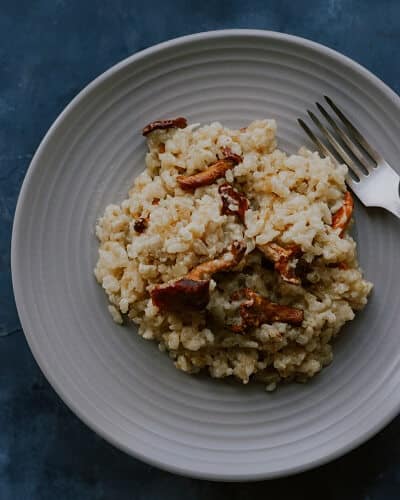
Risotto with Mushrooms
BAROLO SHOPPING TIPS
When shopping for Barolo wines, read bottle labels carefully. Barolo is a protected designation of origin, but there is also a prestigious winery called “Marchesi di Barolo,” and not all of their wines belong to the DOCG category. So make sure you do not confuse the two. Besides, you might come across wines from the region that were not made according to the official winemaking rules, so they legally are not Barolo wines.
Original DOCG wines start at around 35 USD. Here are some great entry-level wines to try:
- type: red, still, Vintage
- origin: Italy, Piedmont
- varietal: Nebbiolo
- alcohol: 14.5%
Damilano Barolo Lecinquevigne 2015
- type: red, still, Vintage
- origin: Italy, Piedmont
- varietal: Nebbiolo
- alcohol: 14.5%
- type: red, still, Vintage
- origin: Italy, Piedmont
- varietal: Nebbiolo
- alcohol: 14.0%
Better wines cost around 100 USD:
Paolo Conterno Barolo Ginestra 2016
- type: red, still, Vintage
- origin: Italy, Piedmont
- varietal: Nebbiolo
- alcohol: 15.5%
Marchesi di Barolo Barolo Sarmassa 2014
- type: red, still, Vintage
- origin: Italy, Piedmont
- varietal: Nebbiolo
- alcohol: 14.5%
Cordero di Montezemolo Barolo Enrico VI 2015
- type: red, still, Vintage
- origin: Italy, Piedmont
- varietal: Nebbiolo
- alcohol: 15.0%
The best of the best cost several hundred, sometimes more than 1,000 dollars. Typically, these are at least 10 years old:
Cavallotto Barolo Bricco Boschis 2010
- type: red, still, Vintage
- origin: Italy, Piedmont
- varietal: Nebbiolo
- alcohol: 14.4%
Vietti Barolo Riserva Villero 2012
- type: red, still, Vintage
- origin: Italy, Piedmont
- varietal: Nebbiolo
- alcohol: 14.5%
Bartolo Mascarello Barolo 2010
- type: red, still, Vintage
- origin: Italy, Piedmont
- varietal: Nebbiolo
- alcohol: 14.0%
FINAL WORDS
Without a doubt, Barolo is one of the best but also most controversial wines that Italy has to offer. Its dominant tannins and the long aging time might scare some wine lovers away. But nobody who has ever tasted a well-aged Barolo cannot deny that it is a fantastic wine. If you have not tried it yet, you definitely should.


